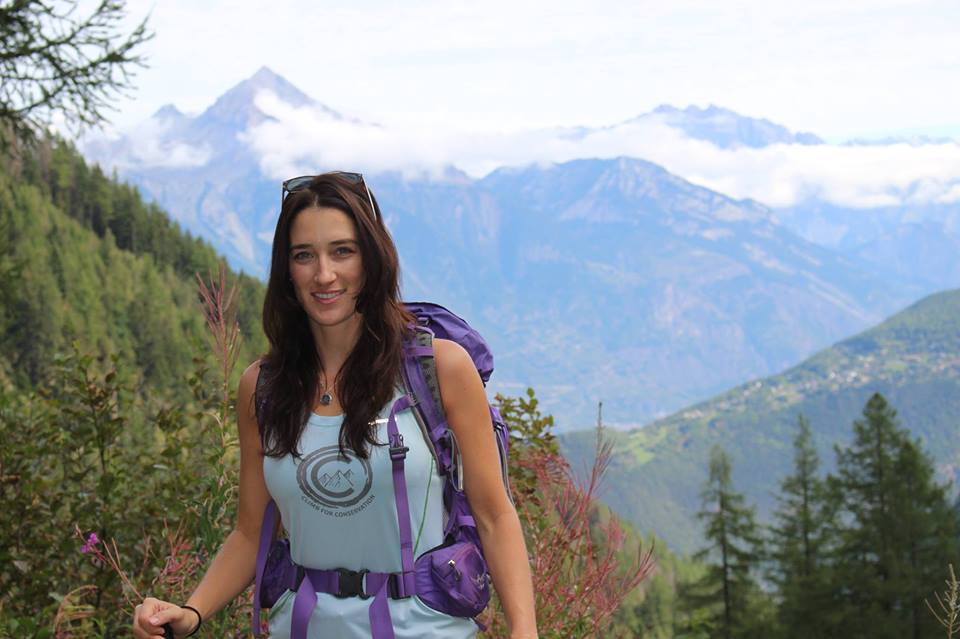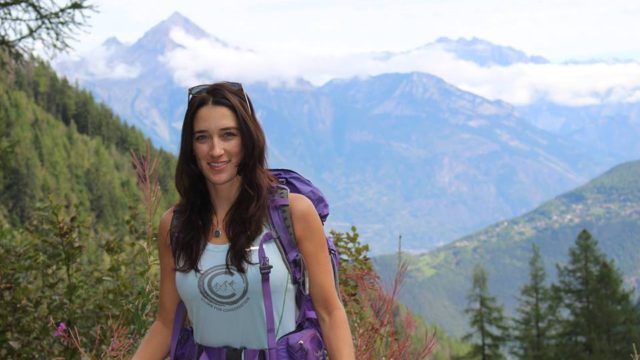By Tom Robotham
One can’t help but be impressed by Ginna Kelly’s resume. Indeed, after chatting with the 35-year-old Virginia Beach resident for an hour or so recently I asked her if there’s anything she hasn’t accomplished. She laughed gently, in a way that people do when they’re proud of their achievements but still deeply grounded in humility.
After graduating from Virginia Tech in 2003, and William & Mary Law School in 2007, she moved to Colorado to take a job with a law firm. It was there that she discovered her greatest passion: mountain climbing.
Many people pursue the sport for the sheer exhilaration, but for Ginna that wasn’t enough. In 2010, she started a non-profit organization called Climb for Conservation with the mission of raising money for the protection of endangered species all over the world. Since then she has led more than 350 people on climbs around the world, and the organization has donated more than $75,000 to protect endangered species. “I just want to do my part to make the world a better place,” she says.
Ever on the lookout for opportunities for personal growth, she took a break from law in 2013 to enroll in Yale Divinity School. She graduated last year with her master’s degree in religion and theology.
This year she started practicing law again fulltime with Green, Hampton & Kelly in Chesapeake. More recently still she got a modeling contract with Modelogic in Richmond.
In spite of all this, she is continually thinking about her next mountain expedition.
I’m primarily interested in talking to you about your mountain-climbing experiences. But before we get to that, I’d love to hear more about your reasons for going to divinity school.
I grew up going to an Episcopal Church. I’ve never been strictly religious, but I am a very spiritual person, and religion is something that has always intrigued me. I think there are many spiritual paths, and I wanted an opportunity to study it more deeply. It was two and a half years of intense reading and studying—and just reflecting on life. I guess you could say that I’m on a spiritual quest to find answers to key questions: “What makes life meaningful?” and “What is the good life?” It’s a lifelong quest. Divinity School was just one step.
Was your spirituality a motivation for climbing mountains?
Yes, I think it’s all related. You’re seeking to find something up there, in terms of the sights, but even more so to find something in yourself—your ability to push past challenges and boundaries. Being in nature is a very spiritual experience. It’s rooted in my childhood. I started hiking as a kid, around here, and went to a nature camp out in Vesuvius, Virginia every summer. Eventually I became a counselor there. And then on our family vacations, we always went to a national park. When I moved to Colorado I began to take it even more seriously. I was working for a law firm, but I hiked as much as possible.
What was your first serious climb?
There are lots of “fourteeners”—that’s shorthand for 14,000-foot peaks—in Colorado. The first one was Mount Elbert, but that’s a pretty easy one—it’s just a walk up. I did others there, but my first really big climb was Mount Kilimanjaro in 2012. It was a big leap from 14,000 feet to over 19,000 feet. You don’t know how your body’s going to respond to the altitude. Some people do OK, and some people get really sick. The response doesn’t have to do with your fitness. But I did really well. I’ve climbed Kilimanjaro twice more since then. It’s not scary. It’s exhilarating. It’s a long hike, and there are some steep sections at the end. But just getting up there after 5 or 6 days is such a sense of accomplishment. At that altitude you kind of feel like a zombie. You’re exhausted physically and also light-headed. But it’s a fun one; it’s one of my favorites, not only because of the climb but seeing the wild life.
Can you tell me about a climb that was frightening?
Yes. It was on Mount Antisana, the highest volcano in Ecuador. It’s one of the most remote and one of the least climbed. I did it last January with three other people, two girlfriends and a man named Fredy, who is one of the best climbers and guides there. I really feel safe going with him. But the conditions were terrible—we were in a blizzard, and there was a whiteout. In spite of that, we made it to the summit, but on the way down we were all exhausted. It’s about an eight-hour climb just to get to the top, and there are tons of crevasses with drops of thousands of feet.
We were roped together: Fredy was first and I was second. At one point we were walking along and Fredy just disappeared. He had fallen into a crevasse, and I started sliding after him. Fortunately I managed to self-arrest, which is when you take your ice axe and just kind of fall in the snow. I could feel the rope pulling me. It was really scary because he was the leader, and I’m thinking, ‘Oh God, if something goes wrong with Fredy, how are we going to recover from this? Luckily he was able pull himself out.
That’s your biggest fear on these glacier peaks—falling into a crevasse. If the whole team goes down, that’s not good. Plus, there was no one else was on the mountain that day; we didn’t see any other people, so I remember thinking that if we all go down no one is going to find us. But luckily it all worked out. Afterwards I was just, like, “Get me off of this mountain.”
What was your most recent trip?
We just did the Tour du Mont Blanc, a 110-mile circuit hike that began in Chamonix, France. It’s a great place—kind of like Aspen on steroids. There’s lots of skiing and paragliding—people who are living to adventurous extremes. And the trail itself is great: beautiful views, wonderful food. One day you’re in France, the next day in Italy, the next day in Switzerland, so every day you’re having a new cultural experience. It’s one of the easier hikes that we do, but you still have to be in shape and be OK at higher altitudes. But I would say it’s more “glamping” (luxury camping) than what we usually do. The hut system there is really nice—not like trail huts here. They’re big cabins with bunk beds, showers, and a three-course meal at night. I’m looking forward to doing that again next September.
What about your next serious climb?
Next July, we’re going to do Mount Elbrus, the highest mountain in Russia. It’s over 18,000 feet. I just starting to get people signed up. It’s about a 2-day climb, but it’s 10 days over there, including practice climbing with crampons, ice axes and ropes.
Of course Mount Everest is always in the back of my mind. For a mountaineer, it’s the ultimate challenge. It’s the tallest mountain in the world. It takes two months to climb it. Just to trek into base camp is two weeks. Then you have to climb to camp one, then back down. Then you climb to camp 2, then back down again so you can acclimate. And there are literally two days in May where the jet stream is not coming over the top of the mountain and you can go to the summit. So all these things have to line up. It’s also not a cheap thing to do. But for me it would be a great accomplishment. I feel ready for it, but I haven’t decided yet because it’s such a big commitment.
In contrast to that, I also want to do Camino de Santiago in Spain, which is more of a spiritual journey. And I want to do Old Rag, here in Virginia. I’ve never done it.
What sorts of people have you met doing these hikes?
A wide range, from people in their 20s to their 70s. Everyone is into the outdoors and going on adventures, but there are people from all walks of life, and political views vary across the spectrum. It’s not all liberal “eco people.” On the last Kilimanjaro trip we had a Navy Seal, a Marine, business executives. Seven hours a day on the trail, and sitting around at night, you get into all sorts of discussions. But everyone gets really close and bonded together.
How long do you think you’ll keep doing this?
I think this is something I’ll be doing forever. I know people who keep hiking into their 80s. It’s really a great lifelong sport. Instead of just going on vacation, you have this theme of mountains. It’s really more than a sport, actually. It’s a way of life.
For more information visit climbforconservation.org.





